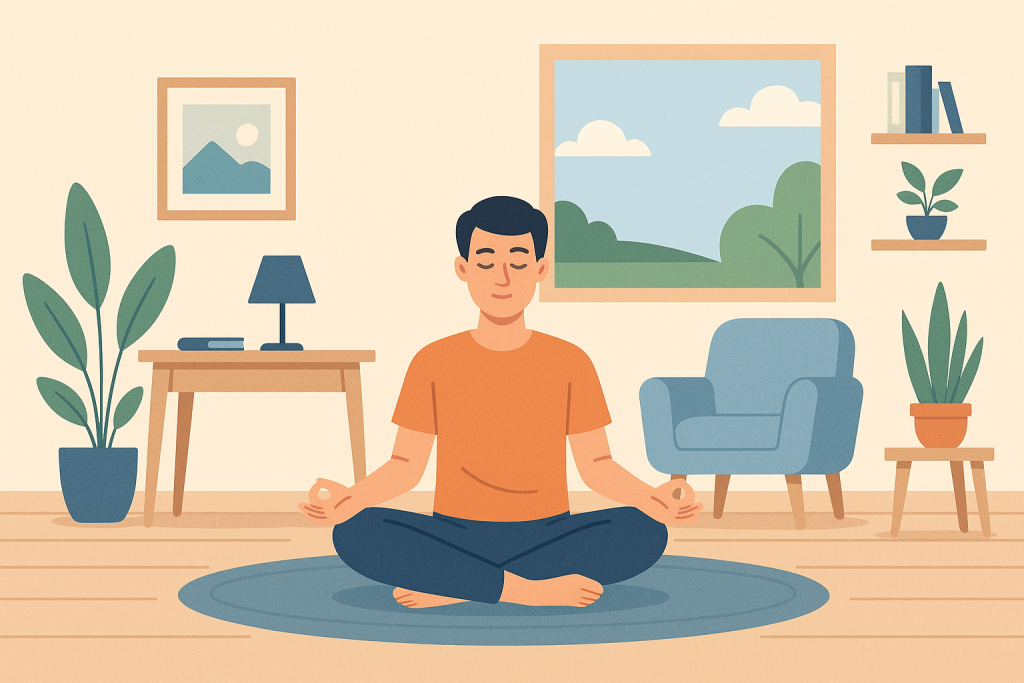Every millisecond, your environment sends signals to your brain—about lighting, color, sound, shape, and more. The right design clears mental clutter, sharpens focus, and supports overall well-being. Here’s how environment design can transform your mind—and what trends are emerging in 2025.

1. Embrace Biophilic Design to Reduce Stress 🌿
What it is:
Biophilic design connects you with nature—plants, natural light, water, textures, even organic curves.
Why it clears your mind:
- Reduces stress and improves mood—plants in offices cut cortisol levels, while views of greenery aid attention restoration theory
- Enhances cognitive function—plants, fractal imagery, natural sounds boost memory and concentration .
Trends for 2025:
- Green walls, indoor gardens, digital projections of nature are growing in popularity
- Immersive zones with natural textures and soundscapes support sensory harmony
Quick tips:
- Add potted plants or a mini desk garden.
- Use nature-themed wallpapers or digital screens.
- Pipe in gentle water or forest sounds via white-noise apps or embedded speakers.
2. Light Strategically for Cognitive Boost
Why lighting matters:
- Natural daylight elevates mood by ~15%, productivity by ~25%, and reduces absenteeism
- Light color and intensity affect alertness and memory. A recent VR study showed variable lighting conditions improved cognitive task performance, depending on time of day
Trends for 2025:
- Circadian lighting systems that adjust warmth and brightness throughout the day support mental rhythm .
- Smart windows and glazing regulate light and glare based on outdoor conditions.
Quick tips:
- Maximize daylight access—sit near windows, use translucent curtains.
- Consider a programmable desk lamp—cool white light at peak focus times.
3. Optimize Layout and Shape for Focus
The science:
Workspace layout—including shape of rooms and flow—impacts mood, stress, and creativity. VR studies show curved rooms with nature views improve stress, mood, and cognitive performance.
Trends for 2025:
- Zones for different activities: collaborative, focused, restful
- Quiet computing zones—enclosed spaces or pods to reduce auditory distractions.
Quick tips:
- Use room dividers or furniture to create distinct zones.
- Add curved or rounded furniture to soften angular stress.
- Dedicate a quiet nook—noise-cancelling headphones mandatory.
4. Use Color, Texture & Art for Mental Balance
Color’s impact:
- Blues and greens lower blood pressure; whites provoke alertness—though too much blank space can be distracting .
- Fractal patterns—like natural leaf shapes—balance mental engagement and relaxation .
2025 trends:
- Art walls and subtle textures that evoke calm focus.
- Virtual or digital “artscapes” that change over time to avoid visual monotony.
Quick tips:
- Paint one accent wall in a soothing green or blue.
- Hang nature-themed artwork or fractal pattern prints.
- Swap art seasonally to refresh your perception.
5. Activate Your Senses Intentionally
A truly clear mind responds to not just sight, but sound, smell, and touch.
Sensory strategies:
- Soft natural light, water sounds, citrus or pine diffusers, soft rugs or felt panels—each reminds your brain to reset .
- Multi-sensory zones balance stimulation—too much can distract, but well-timed use can enhance memory and focus .
Quick tips:
- Equip a small diffuser with lavender or peppermint.
- Install felt-covered panels or soft furnishings.
- Play gentle nature sounds during breaks.
6. Tailor Spaces for Neurodiversity & Adaptation
Why it matters:
Inclusive design supports mental clarity across neurotypes. Noise control and clear wayfinding ease cognitive load .
Adaptive trend:
- AI-powered spaces that sense stress and adjust light, sound, or visuals dynamically .
Quick tips:
- Use acoustic partitions or white noise machines.
- Add clear signs or visual indicators for zones.
- Incorporate flexibility—reconfigurable furniture, adjustable lighting.
7. Leverage VR & Digital Tools for Clarity on Demand
When you can’t redesign immediately, virtual solutions help:
Virtual nature & adaptive environment tools:
- VR “nature baths” mimic forest therapy—Shinrin-yoku in digital form boosts clarity and lowers stress.
- Apps can simulate daylight cycles or ambient nature visuals to refresh your space.
Quick tips:
- Use VR or nature-sound apps for timed focus breaks.
- Integrate a small screen maximizing calming visual or ambient light effects.
A Step-by-Step Guide to Clear-Mind Environment Design
- Audit your space:
- Track light exposure, noise levels, access to greenery, and zone functionality.
- Prioritize quick wins:
- Move plants closer, adjust light bulbs to cooler tones, paint a calming accent wall.
- Redesign for zones:
- Create focus, collaboration, and rest zones with distinct furniture/layouts.
- Layer your sensory approach:
- Combine sound, color, texture, and smell for balanced stimulation.
- Measure effects:
- Keep a mood and productivity journal weekly. Adjust after two weeks.
- Scale up:
- Plan bigger upgrades—biophilic windows, modular walls, AI lighting.
- Include neuro-inclusive features:
- Add quiet pods, signage, adjustable desks/lights.
- Use digital supplements:
- VR breaks, day-cycle lighting apps, or ambient recall screens.
Why This Matters in 2025
Our environments have never been more cognitively demanding. With rising screen time, remote work, and mental-health pressures, environment design isn’t luxury—it’s clarity tech.
According to a 2024 review of nearly 1,000 studies, restorative environment research is booming, underlining the mental recovery impact of designed space.
Companies recognize ROI:
A Capital One survey found 90% of workers agree well-designed spaces boost performance.
Employees want sensory wellbeing, quiet systems, and biophilia—this is shaping new workplace investments in 2025 .
Final Thoughts
Environment design isn’t just aesthetics—it’s cognitive architecture. Through lighting, natural elements, sensory orchestration, adaptive zones, and inclusive layouts, you can craft spaces that foster mental clarity—even on the busiest days.
References
Harvard Health Publishing (2024) How light affects our mood and cognitive function. Available at: https://www.health.harvard.edu/mind-and-mood/how-light-affects-our-mood-and-cognitive-function (Accessed: 19 June 2025).
Psychology Today (2024) The Mental Health Benefits of Nature-Based Design. Available at: https://www.psychologytoday.com/us/blog/the-new-brain/202404/the-mental-health-benefits-of-nature-based-design (Accessed: 19 June 2025).
Fast Company (2024) Why Quiet Spaces and Natural Light Are the Future of Workplace Design. Available at: https://www.fastcompany.com/91047709/quiet-workspaces-and-natural-light-design-trends (Accessed: 19 June 2025).






